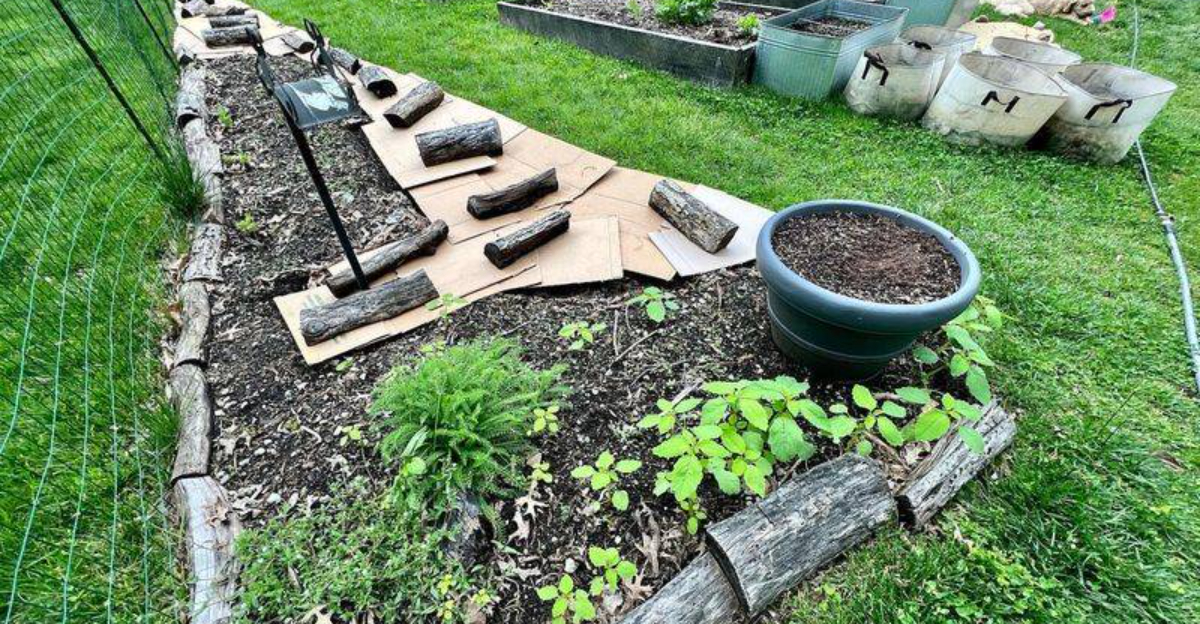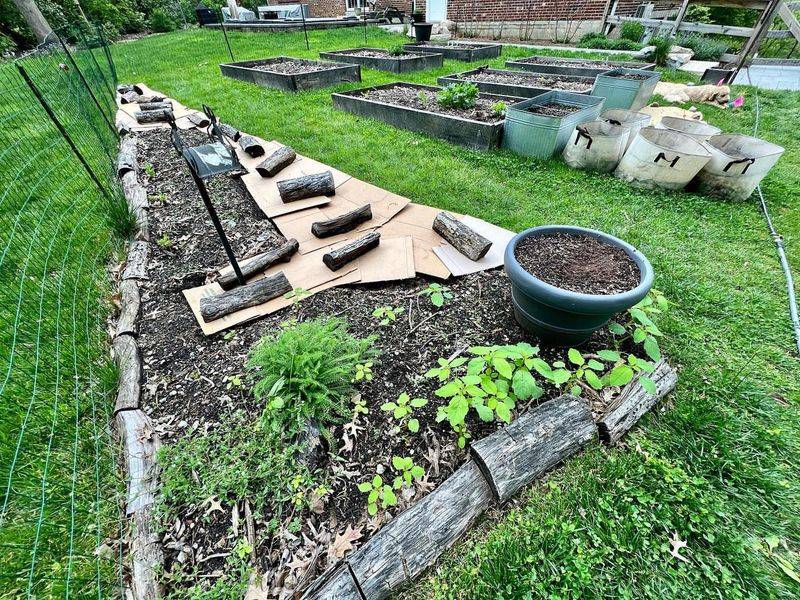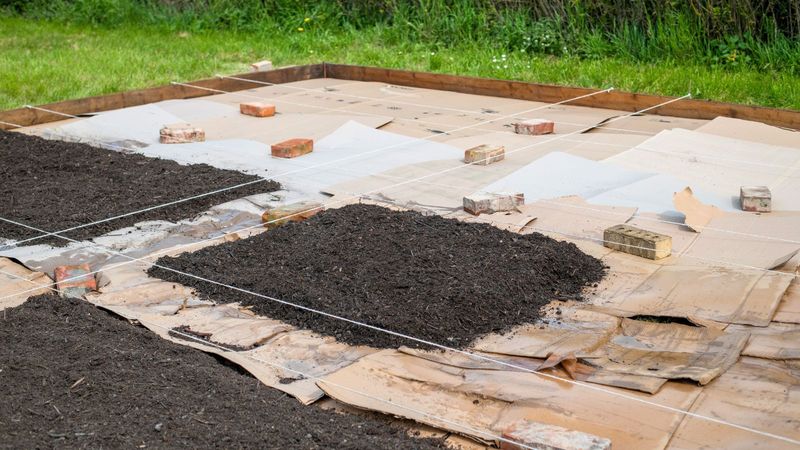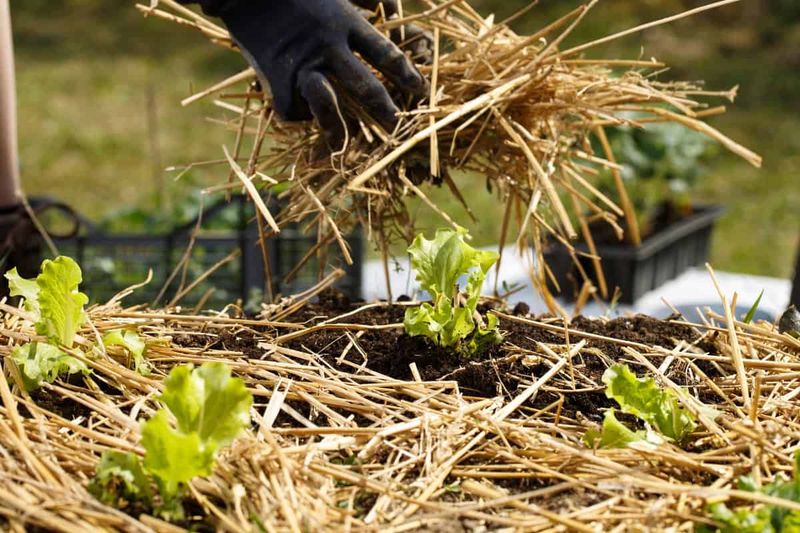Strong sun, tough clay, and endless weeds create a battle that exhausts even the most determined gardener, yet one simple tactic flips the script.
A few sheets of cardboard pair with rich compost, and the soil below starts to shift in remarkable ways.
Weeds surrender, moisture settles in perfectly, and earthworms rush to the scene as though invited to a feast.
This straightforward approach turns problem patches into productive spaces, and many who try it never look back.
Cardboard Creates A Weed-Blocking Foundation
Plain brown cardboard acts as nature’s weed barrier when you lay it directly on the ground.
Remove any tape, labels, or glossy sections before spreading boxes flat across your garden bed.
Overlap the edges by at least six inches so weeds can’t sneak through the cracks.
The cardboard smothers existing grass and weeds by blocking sunlight they need to grow.
Within weeks, those unwanted plants die off naturally without harsh chemicals or back-breaking digging.
Kansas gardeners love this method because it eliminates hours of weeding later in the season.
As a bonus, the cardboard breaks down over several months, adding carbon to your soil.
Earthworms and beneficial microbes feast on the decomposing material, improving soil structure from below.
Choose corrugated cardboard over thin sheets for better weed suppression and longer-lasting coverage.
Water the cardboard thoroughly after laying it down to help it conform to the soil surface.
Wet cardboard stays in place better during Kansas winds and starts breaking down faster.
Within one growing season, you’ll barely recognize the transformation beneath your feet.
Compost Layers Feed Plants Naturally
Piling compost on top of your cardboard layer creates a nutrient powerhouse for hungry plants.
Aim for three to four inches of finished compost to give roots plenty of organic matter to explore.
Kitchen scraps, aged manure, and decomposed leaves all make excellent compost choices for this technique.
Compost releases nutrients slowly throughout the growing season, feeding plants steadily without the risk of fertilizer burn.
Nitrogen, phosphorus, and potassium become available as microorganisms continue breaking down organic matter.
Your vegetables and flowers get a balanced diet without you buying expensive synthetic fertilizers.
Kansas soil often lacks organic matter due to hot summers and drying winds.
Adding compost improves water retention dramatically, helping plants survive drought conditions better.
The dark color also absorbs heat in spring, warming soil faster for earlier planting.
Mix different compost types for the best results—combine homemade kitchen compost with purchased mushroom compost or composted manure.
Each type brings unique beneficial bacteria and nutrients to your garden ecosystem.
Within months, you’ll notice healthier plants with deeper green leaves and stronger stems.
Moisture Retention Saves Water And Money
Sheet mulching acts like a sponge, holding moisture in the root zone where plants need it most.
The cardboard and compost layers reduce evaporation by shielding soil from direct sunlight and drying winds.
Kansas gardeners report cutting their watering frequency in half after implementing this method.
During summer heat waves, unmulched soil can lose inches of moisture daily through evaporation.
Your sheet-mulched beds stay consistently moist even when temperatures soar above ninety degrees.
Plants experience less stress, which means better yields and fewer problems with blossom drop or wilting.
The improved water retention also prevents nutrient leaching during heavy rains.
Instead of washing away valuable minerals, water soaks slowly through the layers, carrying nutrients down to plant roots.
Your compost investment works harder and lasts longer in the soil.
Calculate your water savings by monitoring your usage before and after sheet mulching.
Many Kansas gardeners save hundreds of gallons per season, lowering utility bills significantly.
The environmental benefits add up too—less water consumption helps preserve local aquifers and streams for future generations.
No-Dig Method Protects Soil Structure
Traditional tilling destroys the delicate network of fungal threads and earthworm tunnels that make soil healthy.
Sheet mulching builds gardens without disturbing this underground ecosystem.
Simply layer materials on top and let nature do the heavy lifting for you.
Soil organisms create channels that allow air and water to penetrate deep into the ground.
When you till, you collapse these pathways and bring dormant weed seeds to the surface where they can germinate.
The no-dig approach keeps beneficial structures intact while suppressing weeds naturally.
Kansas clay soil especially benefits from this gentle treatment.
Tilling clay when it’s too wet creates brick-hard clumps, while tilling when dry produces dusty powder.
Sheet mulching works regardless of moisture conditions, making it perfect for unpredictable prairie weather.
Over time, earthworms pull organic matter from your compost layer down into deeper soil levels.
Their tunneling action loosens compacted earth better than any machine could.
You’ll notice improved drainage and easier root penetration without ever picking up a shovel or rototiller blade.
Free Materials Make It Budget-Friendly
Grocery stores, appliance shops, and liquor stores regularly give away clean cardboard boxes for free.
Call ahead to reserve large refrigerator or furniture boxes that cover more ground with fewer pieces.
Most managers appreciate someone hauling away their recycling instead of paying disposal fees.
Compost costs nothing if you make it yourself from kitchen scraps, grass clippings, and fallen leaves.
Even buying compost in bulk from municipal facilities or local farms costs far less than chemical fertilizers.
Kansas has numerous composting operations that sell quality products at reasonable prices.
Compare this method to purchasing landscape fabric, which tears easily and eventually becomes trash.
Cardboard costs nothing and improves your soil as it decomposes.
You’re building fertility instead of creating waste that ends up in landfills.
Some Kansas communities offer free wood chip deliveries from tree trimming services.
Layer these over your cardboard and compost for extra weed suppression and moisture retention.
Within two years, you’ll have incredibly rich soil that produces bumper crops without ongoing expenses for amendments or pesticides.
Gradual Decomposition Builds Lasting Fertility
Watching cardboard transform into soil feels almost magical as months pass.
Initially stiff and brown, the layers soften and darken as microorganisms break down cellulose fibers.
By the end of the first season, you can barely distinguish where cardboard ends and soil begins.
This slow release of nutrients prevents the feast-or-famine cycle that chemical fertilizers create.
Plants receive steady nutrition as decomposition progresses, supporting consistent growth throughout the season.
Root systems develop more extensively when searching through decomposing organic matter for nutrients.
The carbon in cardboard balances nitrogen-rich materials like grass clippings and kitchen scraps.
Proper carbon-to-nitrogen ratios prevent smelly, slimy compost piles and create ideal conditions for beneficial bacteria.
Kansas gardeners appreciate how this balance produces sweet-smelling, crumbly finished compost.
After two or three years of sheet mulching, your soil will be unrecognizable compared to where you started.
Hard clay or sandy patches transform into loose, dark earth that crumbles easily in your hands.
Established beds may only need thin compost top-dressings annually to maintain their fertility, saving you even more time and money long-term.
Perfect Timing For Kansas Growing Seasons
Fall installation gives sheet mulch all winter to break down before spring planting.
Lay cardboard and compost in September or October after harvesting summer crops.
Kansas winters provide moisture through snow and rain, keeping decomposition active even during cold months.
By April, your beds will be ready for planting without additional preparation.
The cardboard will have mostly decomposed, creating a soft planting surface for seeds and transplants.
Early spring vegetables like lettuce, peas, and spinach thrive in the cool, moisture-rich environment.
Spring installation works too if you plan ahead.
Put down sheet mulch in March for planting warm-season crops in May.
The two-month window allows enough decomposition for tomatoes, peppers, and squash to establish roots.
Just add extra compost if the cardboard hasn’t fully broken down yet.
Some Kansas gardeners sheet mulch in stages, preparing different beds throughout the year.
This spreads out the work and ensures you always have planting space ready when inspiration strikes.
The flexible timing makes this technique accessible even for busy families with packed schedules and competing priorities demanding their attention daily.








